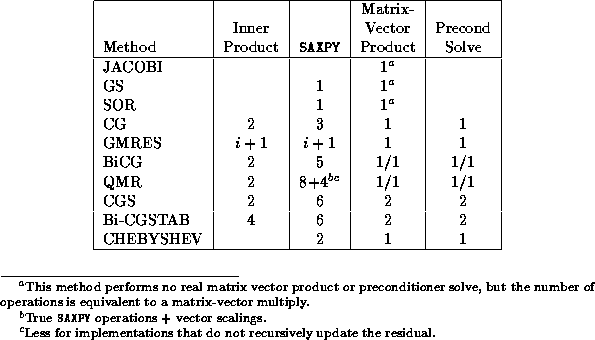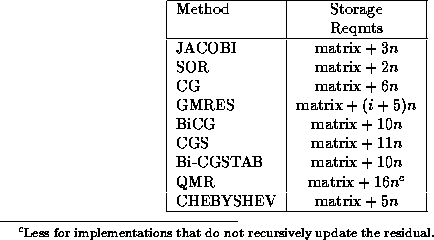Computational Aspects of the Methods





Next: A short history
Up: Iterative Methods
Previous: Implementation
Efficient solution of a linear system is largely a function of the
proper choice of iterative method. However,
to obtain good performance, consideration must also be given to the
computational kernels of the method and how efficiently they can be
executed on the target architecture. This point is of particular
importance on parallel architectures; see § .
.
Iterative methods are very different from direct methods in this
respect. The performance of direct methods, both for dense and sparse
systems, is largely that of the factorization of the matrix. This
operation is absent in iterative methods (although preconditioners may
require a setup phase), and with it, iterative methods lack dense
matrix suboperations. Since such operations can be executed at very
high efficiency on most current computer architectures, we expect a
lower flop rate for iterative than for direct methods.
(Dongarra and Van der Vorst [74] give some
experimental results about this, and provide a benchmark code
for iterative solvers.)
Furthermore,
the basic operations in iterative methods often use indirect
addressing, depending on the data structure. Such operations also have
a relatively low efficiency of execution.
However, this lower efficiency of execution does not imply anything
about the total solution time for a given system. Furthermore,
iterative methods are usually simpler to implement than direct
methods, and since no full factorization has to be stored, they can
handle much larger systems than direct methods.
In this section we summarize for each method
- Matrix properties. Not every method will work on every problem
type, so knowledge of matrix properties is the main criterion for
selecting an iterative method.
- Computational kernels. Different methods involve different
kernels, and depending on the problem or target computer architecture
this may rule out certain methods.

Table: Summary of Operations for Iteration  .
``a/b'' means ``a'' multiplications with the matrix and ``b'' with
its transpose.
.
``a/b'' means ``a'' multiplications with the matrix and ``b'' with
its transpose.
Table  lists the storage required for each method
(without preconditioning). Note that we are not including the storage
for the original
system
lists the storage required for each method
(without preconditioning). Note that we are not including the storage
for the original
system  and we ignore scalar storage.
and we ignore scalar storage.

Table: Storage Requirements for the Methods in iteration  :
:
 denotes the order of the matrix.
denotes the order of the matrix.
- Jacobi Method
- Extremely easy to use, but unless the matrix is ``strongly''
diagonally dominant, this method is probably best only considered
as an introduction to iterative methods or as a preconditioner in
a nonstationary method.
- Trivial to parallelize.
- Gauss-Seidel Method
- Typically faster convergence than Jacobi, but in general not
competitive with the nonstationary methods.
- Applicable to strictly diagonally dominant, or symmetric
positive definite matrices.
- Parallelization properties depend on structure of the
coefficient matrix. Different orderings of the unknowns have
different degrees of parallelism; multi-color orderings may give
almost full parallelism.
- This is a special case of the SOR method, obtained by
choosing
 .
.
- Successive Over-Relaxation (SOR)
- Accelerates convergence of Gauss-Seidel (
 , over-relaxation); may yield convergence when Gauss-Seidel fails
(
, over-relaxation); may yield convergence when Gauss-Seidel fails
( , under-relaxation).
, under-relaxation).
- Speed of convergence depends critically on
 ; the
optimal value for
; the
optimal value for  may be estimated from the spectral
radius of the Jacobi iteration matrix under certain conditions.
may be estimated from the spectral
radius of the Jacobi iteration matrix under certain conditions.
- Parallelization properties are the same as those of the
Gauss-Seidel method.
- Conjugate Gradient (CG)
- Applicable to symmetric positive definite systems.
- Speed of convergence depends on the condition number; if
extremal eigenvalues are well-separated then superlinear
convergence behavior can result.
- Inner products act as synchronization points in a parallel
environment.
- Further parallel properties are largely independent of the
coefficient matrix, but depend strongly on the structure the
preconditioner.
- Generalized Minimal Residual (GMRES)
- Applicable to nonsymmetric matrices.
- GMRES leads to the smallest residual for a fixed number of
iteration steps, but these steps become increasingly expensive.
- In order to limit the increasing storage requirements and work
per iteration step, restarting is necessary. When to do so depends
on
 and the right-hand side; it requires skill and experience.
and the right-hand side; it requires skill and experience.
- GMRES requires only matrix-vector products with the
coefficient matrix.
- The number of inner products grows linearly with the iteration
number, up to the restart point. In an implementation based on a
simple Gram-Schmidt process the inner products are independent, so
together they imply only one synchronization point. A more stable
implementation based on modified Gram-Schmidt orthogonalization
has one synchronization point per inner product.
- Biconjugate Gradient (BiCG)
- Applicable to nonsymmetric matrices.
- Requires matrix-vector products with the coefficient matrix
and its transpose. This disqualifies the method for cases where
the matrix is only given implicitly as an operator, since usually no
corresponding transpose operator is available in such cases.
- Parallelization properties are similar to those for CG; the
two matrix vector products (as well as the preconditioning steps)
are independent, so they can be done in parallel, or their
communication stages can be packaged.
- Quasi-Minimal Residual (QMR)
- Applicable to nonsymmetric matrices.
- Designed to avoid the irregular convergence behavior of BiCG,
it avoids one of the two breakdown situations of BiCG.
- If BiCG makes significant progress in one iteration step, then
QMR delivers about the same result at the same step. But when BiCG
temporarily stagnates or diverges, QMR may still further reduce
the residual, albeit very slowly.
- Computational costs per iteration are similar to BiCG, but slightly
higher. The method requires the transpose matrix-vector product.
- Parallelization properties are as for BiCG.
- Conjugate Gradient Squared (CGS)
- Applicable to nonsymmetric matrices.
- Converges (diverges) typically about twice as fast as BiCG.
- Convergence behavior is often quite irregular, which may lead
to a loss of accuracy in the updated residual.
- Computational costs per iteration are similar to BiCG, but the
method doesn't require the transpose matrix.
- Unlike BiCG, the two matrix-vector products are not
independent, so the number of synchronization points in a parallel
environment is larger.
- Biconjugate Gradient Stabilized (Bi-CGSTAB)
- Applicable to nonsymmetric matrices.
- Computational costs per iteration are similar to BiCG and CGS,
but the method doesn't require the transpose matrix.
- An alternative for CGS that avoids the irregular convergence
patterns of CGS while maintaining about the same speed of
convergence; as a result we often observe less loss of accuracy in
the updated residual.
- Chebyshev Iteration
- Applicable to nonsymmetric matrices (but presented in this
book only for the symmetric case).
- This method requires some explicit knowledge of the spectrum
(or field of values); in the symmetric case the iteration
parameters are easily obtained from the two extremal eigenvalues,
which can be estimated either directly from the matrix, or from
applying a few iterations of the Conjugate Gradient Method.
- The computational structure is similar to that of CG, but
there are no synchronization points.
- The Adaptive Chebyshev method can be used in combination with
methods as CG or GMRES, to continue the iteration once suitable
bounds on the spectrum have been obtained from these methods.
Selecting the ``best'' method for a given class of problems is largely
a matter of trial and error. It also depends on how much storage one
has available (GMRES), on the availability of  (BiCG and QMR),
and on how expensive the matrix vector products (and Solve steps with
(BiCG and QMR),
and on how expensive the matrix vector products (and Solve steps with
 ) are in comparison to SAXPYs and inner products. If these matrix
vector products are relatively expensive, and if sufficient storage is
available then it may be attractive to use GMRES and delay restarting
as much as possible.
) are in comparison to SAXPYs and inner products. If these matrix
vector products are relatively expensive, and if sufficient storage is
available then it may be attractive to use GMRES and delay restarting
as much as possible.
Table  shows the type of operations performed per
iteration. Based on the particular problem or data structure, the
user may observe that a particular operation could be performed more
efficiently.
shows the type of operations performed per
iteration. Based on the particular problem or data structure, the
user may observe that a particular operation could be performed more
efficiently.





Next: A short history
Up: Iterative Methods
Previous: Implementation
Jack Dongarra
Mon Nov 20 08:52:54 EST 1995
![]() .
.

 .
``a/b'' means ``a'' multiplications with the matrix and ``b'' with
its transpose.
.
``a/b'' means ``a'' multiplications with the matrix and ``b'' with
its transpose.![]() lists the storage required for each method
(without preconditioning). Note that we are not including the storage
for the original
system
lists the storage required for each method
(without preconditioning). Note that we are not including the storage
for the original
system  and we ignore scalar storage.
and we ignore scalar storage.

 :
:
 denotes the order of the matrix.
denotes the order of the matrix. .
.
 , over-relaxation); may yield convergence when Gauss-Seidel fails
(
, over-relaxation); may yield convergence when Gauss-Seidel fails
( , under-relaxation).
, under-relaxation).
 ; the
optimal value for
; the
optimal value for  may be estimated from the spectral
radius of the Jacobi iteration matrix under certain conditions.
may be estimated from the spectral
radius of the Jacobi iteration matrix under certain conditions.
 and the right-hand side; it requires skill and experience.
and the right-hand side; it requires skill and experience.
 (BiCG and QMR),
and on how expensive the matrix vector products (and Solve steps with
(BiCG and QMR),
and on how expensive the matrix vector products (and Solve steps with
 ) are in comparison to SAXPYs and inner products. If these matrix
vector products are relatively expensive, and if sufficient storage is
available then it may be attractive to use GMRES and delay restarting
as much as possible.
) are in comparison to SAXPYs and inner products. If these matrix
vector products are relatively expensive, and if sufficient storage is
available then it may be attractive to use GMRES and delay restarting
as much as possible.
![]() shows the type of operations performed per
iteration. Based on the particular problem or data structure, the
user may observe that a particular operation could be performed more
efficiently.
shows the type of operations performed per
iteration. Based on the particular problem or data structure, the
user may observe that a particular operation could be performed more
efficiently.